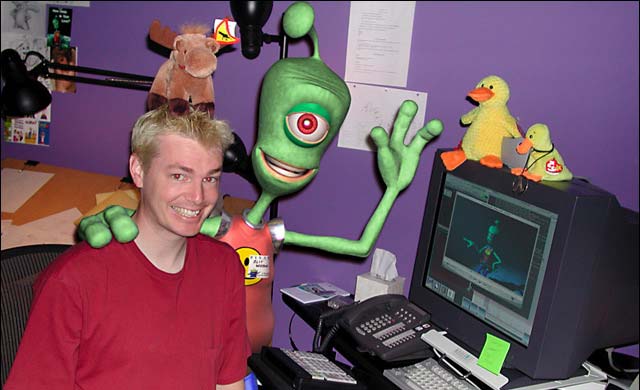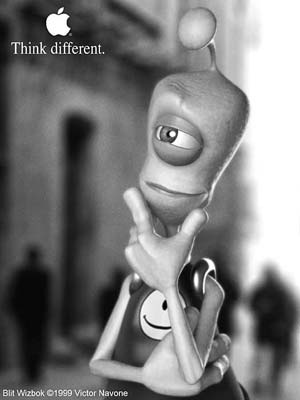
Pixar The Incredibles Animator: Victor Navone

Pixar Animator
Victor Navone: 3D Animator
Tell us about yourself Victor; where are you from and when and how did you get started in animation?
I was born and raised in San Diego, California, and I have a Bachelor of Arts degree in Fine Arts from the University of California, Irvine. I've been involved in 3D production (be it design, effects, modeling, lighting, etc.) since 1994, but it wasn't until 1998 that I started teaching myself character animation on my spare time.
Are you a traditional artist turned 3D animator or did you just jump right into the 3D Software?
I am a traditional artist though I have never done any 2D animation. I do find, however, that my art experience strengthens my animation. It allows me to plan my animation on paper and design appealing poses.

Yes, I do. A solid foundation in art informs any creative work you do in both subtle and profound ways. Also, employers like to see that you have a degree in the field they will be hiring you for.
I can't speak much about game companies any more because I've been out of that industry for years, but I imagine their needs would be more technical. They're probably most interested in people who can do good locomotion cycle animation, convincing physics, etc. An animation studio is going to be more interested in acting ability. If you want to get into a place like Pixar you have to be able to portray thought, emotion and personality through body language alone. Lip-synch exercises are important too. You have to be able to tell a story through action, and you have to have a sense of humor. They like to see some drawing ability if possible. Modeling and rigging skills are fine to have, but not necessary.
There is a lot of competition out there right now, so it's not going to be easy. A great demo reel will speak for itself, whether you have schooling or not, but it's still important to network and to be willing to work your way up from a lesser job. I got very lucky - I don't think that I could get a job at Pixar today with the demo reel I had in 2000. I think timing was a large factor, since Pixar was expanding and I got in before the dot-com crash. Networking is also very important. Sometimes a good demo reel is not enough - you need people in the industry to know your name and help you get in the door.
Focus on being a good animator first. Practice, practice, practice. Get all the feedback you can to improve your work. There are lots of good forums on the internet for displaying your work and getting critiques. If you can meet people in the industry and get feedback from them, even better. This is good for networking as well. Once you have a good animation reel it's time to start sending it around and go to all the big CG conventions, like SIGGRAPH.
Pixar is the dream job for an animator. It's the best place in the world to work. It has a casual, fun atmosphere, lots of talented and friendly people, and we get to make some of the best movies ever. I myself have worked on Monsters, Inc., Finding Nemo, The Incredibles (November 2004) and various short projects.
It can be intimidating but mostly it's inspiring. You want to learn from these people and impress them with your work in return. The bar is always set very high. It's great to be able to get feedback on your work from some of the best artists in the industry.
They were very different experiences, both enjoyable. Presto was a very small company made up almost entirely of young men ages 24 to 30. This made the atmosphere very playful and occasionally raunchy, and the small size meant that I could try out a lot of different roles and gain a wide variety of production skills. It was a great place to grow as and artist and make plenty of useful mistakes. Many Presto alumnus have gone on to jobs in the film industry at places like ILM, Lucasfilm, Weta and Pixar. Pixar has a lot of the same playful spirit that Presto did, but of course its population is much larger more diverse. They employ about 700 people now, so sometimes you may feel that your contribution to a project is relatively small. Then again, it's very exciting to be involved in such big, widely-viewed productions. There's a lot more exposure and prestige than I could ever get at Presto, so professionally it's very gratifiying. The animation department consists of about 60 men and women; it's a tightly knit group, and it often feels a lot like Presto used to. We are definitely the spoiled children of the company. Both Presto and Pixar have been creatively inspiring to work at; Presto for it's freedom and because I was new to the industry, and Pixar for it's talented staff and amazing craftsmanship.

It depends on the project and your role in it. At Presto I was sometimes the creative director on a game, so I would have lots of input (just enough rope to hang myself with, as they say). As an animator at Pixar I have much less, and my role is much more compartmentalized. Being an animator is by nature, however, a very creative job. I get to work directly with the Director, and for any given scene I have a lot of latitude to improvise or introduce new ideas, as long as I satisfy the story and emotional goals of the scene. Of course a Supervising or Directing Animator will have much more input, but ultimately we are all working with what's been handed to us from the previous department. Working in the shorts department at Pixar can be more like Presto was; because of the small size of the teams there may be opportunities for an animator to contribute to the production in ways outside of his or her job description. There is also the potential that an animator could spend some time in another department, such as story, layout or modeling.
What mediums have you created animations for??
Actually I've never done animation for games, only for film and personal work. My work on games included concept design, special effects, modeling, texturing, lighting, rendering and compositing, but no character animation.
What Programs and Hardware do currently work with? And why do you choose to work with these software packages?
At Pixar we use proprietary software running on Linux-based PC's. At home I have a Mac G4 and a Pentium PC (both in need of an upgrade). My favorite software includes Photoshop, After Effects and Animation: Master. I like A:M for it's simplicity and it's great character animation tools. It also runs on Mac and PC and doesn't have demanding CPU requirements. I did my first animations in A:M and I've stuck with it ever since. The guys at Hash, Inc. who make A:M are friends of mine.
Who's work do you admire?
In no particular order: Hayoa Miyazake, Brad Bird, John Lasseter, Tony Fucile, Doug Sweetland, John Kahrs, Milt Kahl, Ward Kimball, Glenn Keane, I could go on.
Where do you get the inspiration for your art?
Life. And other art.
Could you take us through your creative process when starting a new animation project.
I don't have a regular process for this yet, but I usually start a project or an animation scene by doodling on paper. Small thumbnails just to get an idea for camera angles, poses, characters and how shots will flow together. For a story I will write out a brief outline. Once I have an outline and enough thumbnails I will start storyboarding. For Big Bang I drew about 400 storyboards, scanned them, and edited them together with After Effects and Final Cut Pro. I added temporary dialog of my own voice as well as some generic sound effects. I did many revisions to this story reel, and the feedback I got from some fellow artists at Pixar was invaluable. Next I started finalizing designs for characters and vehicles. Once I have everything modeled I will start laying out the shots in 3D and animating them. I can imagine it will be a challenge just to manage and track all of the assets I will be needing to complete the short.
Could you tell us about your new animated short Big Bang?
It's a work in progress. It's 6 minutes long and I have no idea how I'm ever going to finish it. I got the idea in 2001; so far I have the entire story in animatic form, and I've done some of the character and vehicle modeling. I haven't actually started animating anything yet, so I've got a long way to go.
How was the concept of Big Bang conceived?
I thought of it while watering the lawn. I just like the contrast between a giant, powerful, child-like being and a tiny race of aggressive, impotent aliens trying to conquer his head. Once I had this juxtaposition in my mind the story worked itself out pretty easily.
How long will it take to complete Big Bang?
I have no idea. Probably another year or two. Sometimes working at Pixar doesn't leave me with much leftover time or creative energy.
What software packages are being used in the creation of Big Bang?

So far I'm using Animation: Master, Photoshop, After Effects and Cinema 4D.
Have you run into any major production problems during the creation of Big Bang?
Mostly just not having enough time and being too picky about the details. Faster computers would help, too.
Are there any other animated shorts your working on?
I have a few other ideas, but Big Bang has been my exclusive focus for the last few years.
What's next for Victor Navone? Are there any new projects on the horizon?
I'm not sure what my next project at Pixar will be after The Incredibles. As for personal work, I look forward to being done with Big Bang so that I can draw and paint more. I need some instant gratification.
Do you have any advice for the aspiring Animators out there?
Learn the traditional principles for animation. Read The Illusion of Life and The Animator's Survival Kit. Read books on filmmaking in general. Practice, practice, practice. And keep it simple.
Thanks to Victor Navone(http://www.navone.org
)
for agreeing to answer the questions I had for him.




